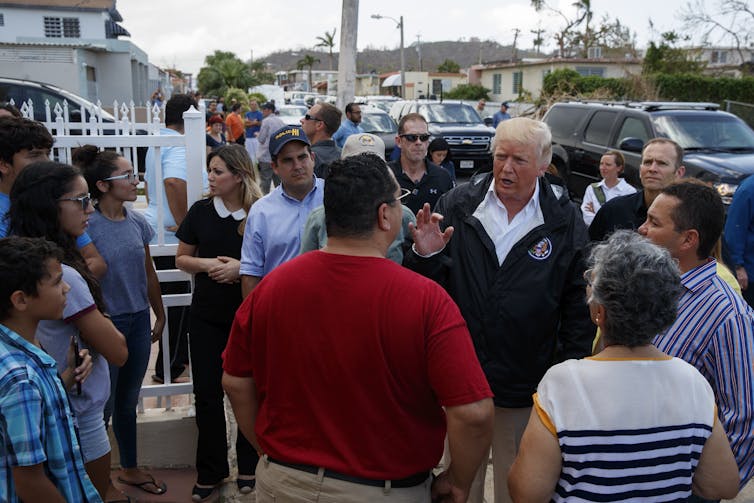 UF Center for Latin American Studies
UF Center for Latin American Studies
October 13, 2017
Carlos A Suárez Carrasquillo, University of Florida
President Donald Trump’s recent visit to Puerto Rico in the aftermath of Hurricane Maria added one more moment of infamy to Puerto Rico’s 119 years as a colonial territory.
Trump was taken to Muñoz Rivera, a middle-class neighborhood in Guaynabo. Most homes there are made of concrete and saw little impact from Hurricane Maria. The governor of Puerto Rico, Ricardo Rosselló, claimed that this location was chosen to save time at the request of the White House staff.

Yet many observers were perplexed that Trump had no direct contact with the most devastated areas on the island. As a scholar of Puerto Rican politics, I wasn’t surprised that some Puerto Rican politicians were willing to play along in this deception. The whole thing reminded me of decades of marketing efforts by Puerto Rican state and municipal governments to lure outsiders by creating the Puerto Rico brand.
But at what cost?
The Puerto Rican government and its municipalities have engaged in aggressive marketing campaigns to attract foreign investment as a way to deal with the many challenges that predate the arrival of Hurricane María: a significant amount of debt, growing unemployment and massive migration to the United States. Puerto Rico’s economy, like that of other Caribbean islands, has been based in its consumption since Europeans landed. Relying on tourism led by foreign capital has led to economic dependency.
During the 1990s and early to mid-2000s, the municipality of Guaynabo, a suburb of the capital San Juan, engaged in an aggressive campaign of branding to increase tax revenue. They sought to attract local and foreign investment in real estate development and industries such as retail and telecommunications. Guaynabo used English to lure wealthier residents who viewed the municipality as prestigious. The socioeconomic profile of the municipality changed.
Residents with more economic means moved in and gentrified the area. This came at the expense of the working-class residents who were eventually bought out or kicked out. Public housing units such as Los Álamos were effectively closed. Residents of historic neighborhoods, such as Vietnam, have been resisting displacement.
The government of Puerto Rico also engaged in significant branding efforts to bring tourists from mostly the eastern and southern U.S. – where the majority of Puerto Rico’s tourists come from. “Puerto Rico Does it Better” was a campaign led by the Puerto Rico Tourism Company in the 1990s. During the last four years, there were efforts to brand Puerto Rico as the “The All Star Island.” The government went to great lengths to get this message across in Europe, arranging a contract worth US$3.5 million with a Spanish soccer team, Sevilla FC, to have the slogan on the front of its jersey.
In the decades preceding Maria, there were increased efforts to attract sports tourism, sun and beach tourism, cruise ship tourism and destination weddings. Puerto Rico took advantage of the economic boom of the 1990s until the Great Recession. Tourism became a staple of the Puerto Rican service economy, and branding became a useful tool for economic growth and stability.
However, this growing focus on branding has had major political cost. Public administration has turned into an effort to please investors, rather than the public that votes politicians into office. Attracting foreign capital through tax breaks has turned problematic when the finances of these foreign investors go sour. Since the early 1990s, government efforts have focused on privatizing the island. Public utilities like water and power have been unable to currently rebuild Puerto Rico, in part because of previous cost-cutting efforts by the government. The public utility companies are now facing increasing debt and a decreasing workforce and are vulnerable to privatization.
Branding also fails to address the political and structural challenges inherent to Puerto Rico’s colonial status. For example, Puerto Rico has no vote in the U.S. Congress, and it’s not a sovereign nation. The island has also been subject to unfair shipping regulations. Puerto Rico has dealt with a mounting debt that is currently addressed by PROMESA. With the significant economic shortcoming many Puerto Ricans of productive age are migrating. Focusing solely on driving tourism fails to address these deep political issues.
In the face of these challenges, Puerto Rico’s public officials must decide how to move forward.
The tragedy that Hurricane María has brought to Puerto Rico is a valuable opportunity to refocus on promoting a strong Puerto Rican business and working class.
If Puerto Rico is interested in a more honest way to brand itself, we should look to a book published more than 20 years ago by Trías Monge entitled “Puerto Rico: The Trials of the Oldest Colony in the World.” In this book, Monge writes about Puerto Rico’s century-old relationship with the United States and argues for an end to the commonwealth status that has been in place since 1952. Whether that means Puerto Rico becoming a state or an independent country remains to be determined by the Puerto Rican people and the U.S. Congress.
![]() An emphasis on infrastructure and production of goods and services rather than an island to be consumed may prove to be a good strategy for a country where hurricanes threaten our existence every year.
An emphasis on infrastructure and production of goods and services rather than an island to be consumed may prove to be a good strategy for a country where hurricanes threaten our existence every year.
Carlos A Suárez Carrasquillo, Lecturer in Political Science, University of Florida
This article was originally published on The Conversation. Read the original article.